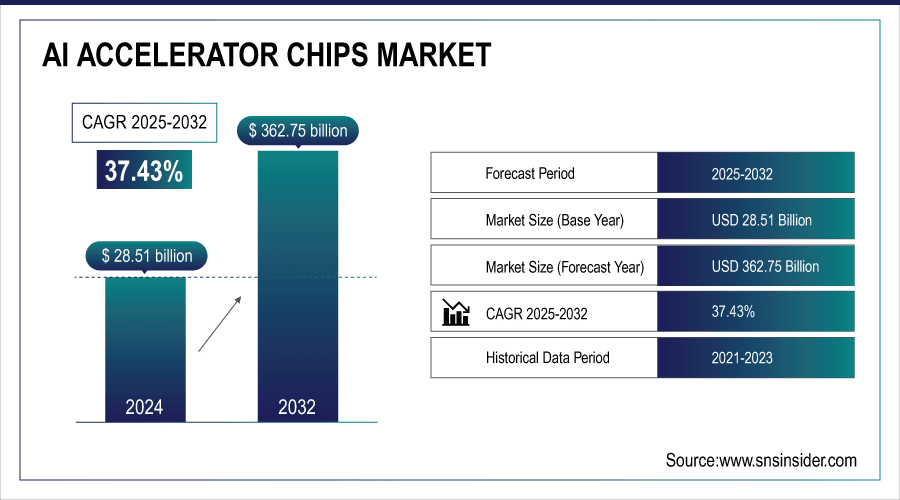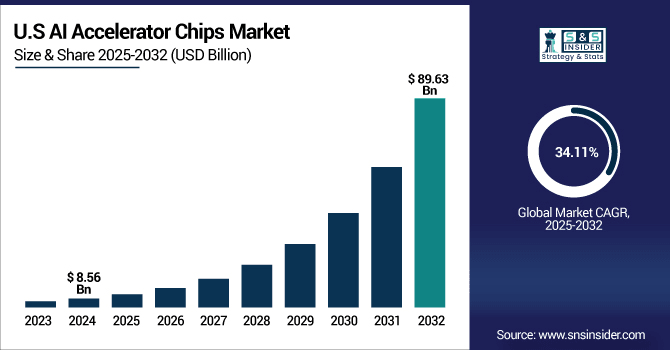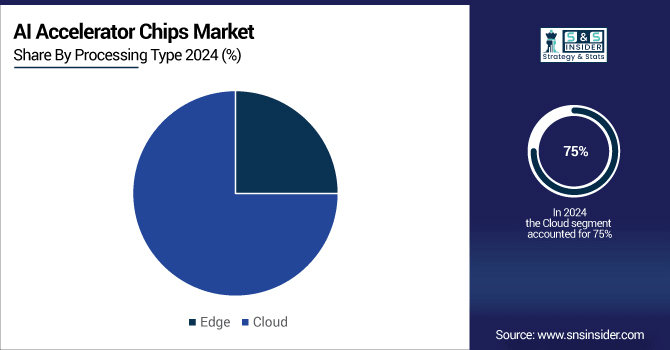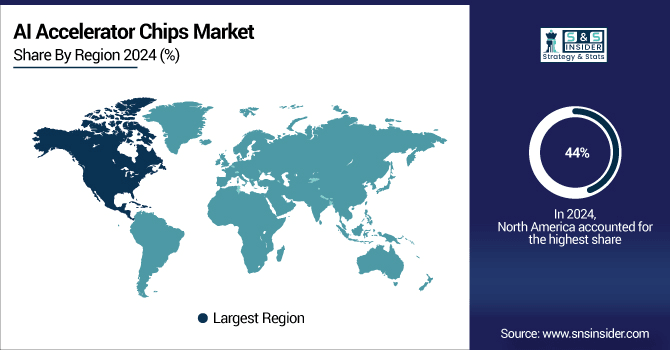AI Accelerator Chips Market Size & Trends:
The AI Accelerator Chips Market size was valued at 28.51 billion in 2024 and is projected to reach USD 362.75 billion by 2032, growing at a CAGR of 37.43% during 2025 to 2032.

To Get more information on AI Accelerator Chips Market - Request Free Sample Report
The AI Accelerator Chips market is expanding rapidly due to the increasing demand for AI-driven applications across industries such as healthcare, automotive, and data centers. Technological advancements in chip architectures and manufacturing processes are enabling higher performance. This growth is influenced by factors such as geopolitical shifts, regulatory changes, and innovations in artificial intelligence that drive the need for more specialized hardware to support complex computations. The market is poised for further growth as AI adoption continues to rise globally.
For instance, on the innovation side, Google’s Ironwood TPU is claimed to offer up to 6x memory bandwidth and better scalability, and Huawei touts its 910C GPU as a national alternative to Nvidia’s H100 amid shrinking U.S. export restrictions. There is a risk of changes the way market operates of increasing competition, technological development, tightening of legislation.
The U.S. AI Accelerator Chips Market size is projected to increase from USD 8.56 billion in 2024 to USD 89.63 billion by 2032 at a CAGR of 34.11%. This growth is attributed to the growing demand for AI in various sectors, development in the field of machine learning, and increased deployment of data center and cloud-based computing.

Nvidia started producing Blackwell AI chips in TSMC’s Phoenix, Arizona factory and is constructing AI supercomputer plants in Texas with Foxconn and Wistron. This is in the context of a USD 500 billion spending on U.S. AI infrastructure over the next four years to boost the country’s semiconductor manufacturing capabilities.
AI Accelerator Chips Market Dynamics:
Drivers:
-
Enhancing Semiconductor Self-Sufficiency Through Advanced Lithography Drive AI Accelerator Chips Growth
5nm chips designed with advancements in DUV lithography and Self-Aligned Octuple Patterning (SAOP) can bypass EUV limitations. They are facilitating the decrease in dependence of foreign technologies and the development of domestic semiconductor industry. This technology-agnostic resiliency enables AI pursuits, driving AI and semiconductor self-dependency. The industry becomes more competitive therefore, nurturing growth and limiting reliance on international supply chains.
For instance, SMIC’s advancements in DUV lithography and multi-patterning, including Self-Aligned Octuple Patterning (SAOP), have enabled the production of 5nm chips, overcoming EUV limitations. This breakthrough aids Huawei’s AI projects, such as the Ascend 920 AI accelerator, showcasing resilience amidst U.S. export restrictions. Leveraging local semiconductor production strengthens self-sufficiency, reducing reliance on foreign technologies and boosting competitiveness in the global semiconductor and AI sectors.
Restraints:
-
Trade Restrictions and Export Controls can Hamper Market Expansion
Export controls on vital raw materials, specifically rare earth materials and special metals, are the major threats for the AI accelerator chips market. They are used to manufacture high-end AI semiconductor chips, and restrictions on their supply can disrupt production schedules, raise costs, and delay the arrival of new technologies to the market. Such situations can reduce the progress of AI accelerator chip designs and production for wide-ranging AI applications.
For instance, AI accelerator chips are facing challenges due to export restrictions, including AMD's USD 800 million charge from U.S. bans on sales to China. This impacts earnings and hinders competition, especially as Nvidia’s upcoming products outpace current offerings.
Opportunities:
-
Enhancing Energy Efficiency in Generative AI Creates Growth Opportunities in the Future Chips
AI inference accelerators play a crucial role in meeting the surging demand for generative AI by delivering improved performance, scalability, and energy efficiency. These enhancements enable faster processing of complex, regulation-intensive models, which is especially important for AI data centers striving to maintain operational efficiency at scale. As generative AI models become more sophisticated, accelerators ensure that data centers can keep pace with demand while optimizing energy usage and computational throughput, making them essential components in the evolving AI infrastructure landscape.
For instance, ZeroPoint and Rebellions have partnered to develop memory-optimized AI accelerators for inference workloads, focusing on boosting efficiency and energy performance. The collaboration aims to unveil advanced products by 2026, enhancing AI infrastructure for sustainable data centers.
Challenges:
-
Escalating R&D Costs Challenge AI Chips Innovation Globally
The development of AI accelerator chips requires large R&D expenditures, which can reach billions of dollars due to the complexity of architecture, fabrication, and power-efficient optimization. These extended, expensive development cycles are a gamble for companies as returns are uncertain, and market conditions change rapidly. That competition creates extra pressure to stay ahead of the pack and deliver next-gen performance, while maintaining profitability.
AI Accelerator Chips Market Segmentation Analysis:
By Chip Type
In 2024, GPUs dominated the chips market with a 35% revenue share due to its multi-purpose nature and prominence in parallel processing. Their ubiquity in training and inference workloads in generative AI, deep learning, and high-performance computing meant they were the first choice for developers and companies wanting scalable and high efficiency AI solutions.
The ASIC segment in the chips market is projected to grow rapidly during the forecast period, registering a robust CAGR of 43.42%. Due to its increasing customer demand for customized, power-efficient chips designed for particular AI inference workloads that deliver higher performance and lower latency than general-purpose GPUs(Graphics Processing Unit).
By Processing Type
In 2024, the cloud segment accounted for approximately 75% of the AI accelerator chips market revenue. This dominance is driven by the surge in demand for scalable, high-performance computing infrastructure required to run generative AI and large language models, making cloud environments a key enabler of AI adoption across industries.
The edge segment of the AI accelerator chips market is experiencing strong growth, with a projected CAGR of 42.26% during 2025 to 2032. This surge is fueled by the rising demand for low-latency, on-device AI processing in sectors, such as automotive, healthcare, and consumer electronics, enabling real-time decision-making without relying on cloud connectivity.

By Industry
In 2024, consumer electronics segment captured approximately 34% of the AI accelerator chips market share , making it one of the largest contributors. This dominance is driven by increasing integration of AI in smartphones, smart home devices, wearables, and AR/VR systems, where real-time processing, personalization, and energy efficiency are essential for user experience.
The automotive segment is projected to be the fastest-growing in the AI accelerator chips market during 2025 to 2032, with a robust CAGR of 42.61%. Growth is fueled by increasing adoption of AI for autonomous driving, advanced driver-assistance systems (ADAS), and in-vehicle infotainment, propelling demand for real-time processing capabilities.
AI Accelerator Chips Market Regional Overview:
In 2024, North America captured 44% AI accelerator chips market share of the total market due to investments into its AI and infrastructure, early adoption of new tech, and the strong presence of leading tech players. This dominance is a strategic advantage for the region with the U.S. being the top contributor to the global market share. American players have played a major role in achieving this lead, with the U.S. becoming the largest country for AI accelerator chips.
Asia Pacific is expected to see substantial growth in the AI Accelerator Chips Market between 2025-2032, with a projected CAGR of 39.58%. This market is gaining traction due to the advancing technology and automation of processes such as artificial intelligence and machine learning, growing AI start-ups across the region, and growing demand for AI-based solutions in end-user industries. China leads in the AI Accelerator Chips Market in the Asia Pacific region because of the substantial investments in the AI infrastructure and quick pace of technological development.
In Europe, the AI Accelerator Chips Market is growing moderately, with key countries like Germany and the UK leading the charge. These nations are at the forefront due to strong investments in AI and tech innovation across various sectors such as automotive, manufacturing, and healthcare. High production costs and infrastructure needs pose challenges.
In Latin America and the Middle East and Africa (MEA), the AI Accelerator Chips Market shows steady, slow growth. fueled by a higher demand for AI solutions across industries including energy, healthcare, and infrastructure. In these areas, there are barriers, such as weak tech infrastructure and lower investment compared to established markets.

Get Customized Report as per Your Business Requirement - Enquiry Now
Key Players Listed in the AI Accelerator Chips Market are:
Key players in the AI Accelerator Chips Market Companies include NVIDIA, AMD, Intel, Google, Qualcomm, Graphcore, Tesla, Baidu, Huawei, Samsung and Others.
Recent Developments:
-
In April 22, 2025, Nvidia plans to manufacture AI supercomputers within the US through partnerships with TSMC, Foxconn, and others. This move aims to mitigate tariff-related disruptions and boost domestic production of Nvidia Blackwell chips in Arizona and AI systems in Texas.
-
In April 22, 2025, Huawei is set to begin mass production of its Ascend 910C AI accelerator for Chinese customers as early as May 2025, following new US sanctions on Nvidia and AMD. The company has already shipped some units and plans to start production of the next-generation Ascend 920 by late 2025.
| Report Attributes | Details |
|---|---|
| Market Size in 2024 | USD 28.51 Billion |
| Market Size by 2032 | USD 362.75 Billion |
| CAGR | CAGR of 37.43% From 2025 to 2032 |
| Base Year | 2024 |
| Forecast Period | 2025-2032 |
| Historical Data | 2021-2023 |
| Report Scope & Coverage | Market Size, Segments Analysis, Competitive Landscape, Regional Analysis, DROC & SWOT Analysis, Forecast Outlook |
| Key Segments | • By Chip Type (GPU, ASIC, FPGA, CPU, Others) • By Processing Type (Edge, Cloud) • By Industry (Automotive, Consumer Electronics, Healthcare, Manufacturing, Others) |
| Regional Analysis/Coverage | North America (US, Canada, Mexico), Europe (Germany, France, UK, Italy, Spain, Poland, Turkey, Rest of Europe), Asia Pacific (China, India, Japan, South Korea, Singapore, Australia, Rest of Asia Pacific), Middle East & Africa (UAE, Saudi Arabia, Qatar, South Africa, Rest of Middle East & Africa), Latin America (Brazil, Argentina, Rest of Latin America) |
| Company Profiles | Key players in the AI accelerator chipset market include NVIDIA, AMD, Intel, Google, Qualcomm, Graphcore, Tesla, Baidu, Huawei, Samsung and Others |

